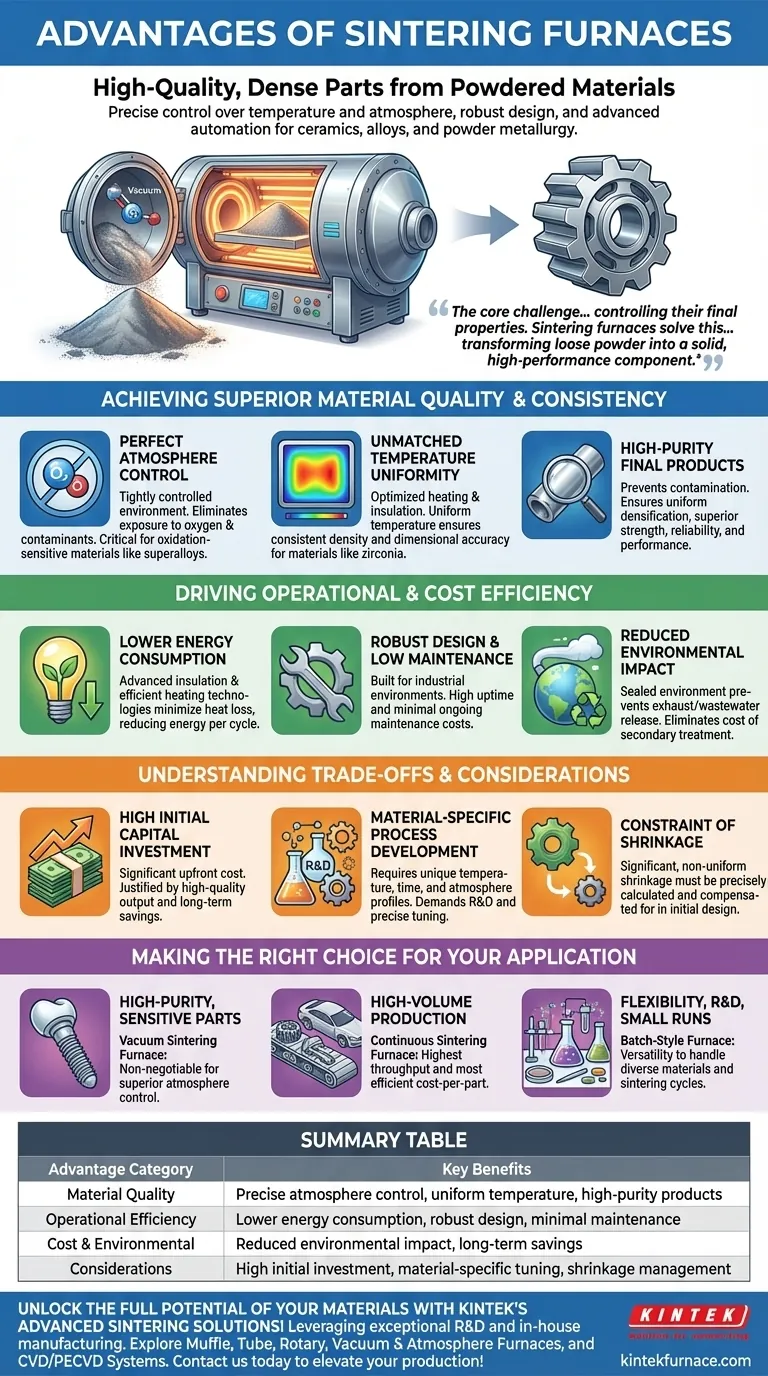In essence, the primary advantages of a sintering furnace are its ability to produce high-quality, dense parts from powdered materials with exceptional consistency and efficiency. This is achieved through precise control over temperature and atmosphere, a robust design that minimizes operating costs, and advanced automation that ensures reliable, safe operation for processing materials like ceramics, alloys, and powder metallurgy products.
The core challenge in modern manufacturing is not just shaping materials, but fundamentally controlling their final properties. Sintering furnaces solve this by providing a highly controlled environment that transforms loose powder into a solid, high-performance component, making them indispensable for producing advanced materials.
Achieving Superior Material Quality and Consistency
The ultimate goal of sintering is to create a finished part with specific, repeatable mechanical and physical properties. The furnace's design is entirely oriented around achieving this outcome.
Perfect Atmosphere Control
Sintering furnaces, particularly vacuum models, excel at creating a tightly controlled environment. This eliminates exposure to oxygen and other contaminants.
This is critical for oxidation-sensitive materials like superalloys, magnetic materials (NdFeB), and certain metal injection molding (MIM) products, ensuring a high-purity, high-quality final part.
Unmatched Temperature Uniformity
These furnaces use optimized heating element distribution and advanced insulation materials, such as graphite layers. This design ensures the temperature is uniform throughout the entire heating chamber.
Uniform temperature is vital for predictable results. For materials like zirconia, which shrinks significantly during sintering, even heating ensures consistent density and dimensional accuracy across the entire component.
High-Purity Final Products
By preventing contamination and ensuring uniform densification, sintering furnaces produce components that are exceptionally clean and free from internal defects. This leads to superior strength, reliability, and performance.
Driving Operational and Cost Efficiency
Beyond part quality, these furnaces are engineered for economical and sustainable operation, directly impacting the bottom line.
Lower Energy Consumption
Modern vacuum sintering furnaces use advanced insulation and efficient heating technologies. This minimizes heat loss, significantly reducing overall energy consumption per cycle.
Robust Design and Low Maintenance
Sintering furnaces are built for industrial environments with robust designs. This translates to high uptime and minimal ongoing maintenance costs, a key factor in calculating total cost of ownership.
Reduced Environmental Impact
The sealed environment of a vacuum furnace prevents the release of exhaust gases or wastewater. This not only helps meet strict environmental standards but also eliminates the cost associated with secondary treatment of operational byproducts.
Understanding the Trade-offs and Considerations
While highly advantageous, sintering technology is not without its specific challenges. Objectivity requires acknowledging these factors.
High Initial Capital Investment
Advanced sintering furnaces, especially highly automated vacuum models, represent a significant upfront capital expenditure. Their cost must be justified by the need for high-quality output and long-term operational savings.
Material-Specific Process Development
Sintering is not a "one-size-fits-all" process. Each material requires a unique profile of temperature, time, and atmospheric conditions. Achieving optimal results demands R&D and precise process tuning.
The Constraint of Shrinkage
The significant, non-uniform shrinkage of parts during sintering is a fundamental aspect of the process. This must be precisely calculated and compensated for in the initial design of the "green" or pre-sintered part, adding a layer of complexity to the manufacturing workflow.
Making the Right Choice for Your Application
The decision to use a sintering furnace depends entirely on your material and production goals.
- If your primary focus is producing high-purity, oxidation-sensitive parts (e.g., medical implants, superalloys): A vacuum sintering furnace is non-negotiable for its superior atmosphere control.
- If your primary focus is high-volume production of ceramic or metal parts: A continuous sintering furnace will provide the highest throughput and most efficient cost-per-part.
- If your primary focus is process flexibility, R&D, or smaller production runs: A batch-style furnace offers the versatility to handle diverse materials and sintering cycles effectively.
Ultimately, investing in the right sintering technology empowers you to transform powdered materials into high-value, high-performance components with confidence.
Summary Table:
| Advantage Category | Key Benefits |
|---|---|
| Material Quality | Precise atmosphere control, uniform temperature, high-purity products |
| Operational Efficiency | Lower energy consumption, robust design, minimal maintenance |
| Cost and Environmental | Reduced environmental impact, long-term savings |
| Considerations | High initial investment, material-specific tuning, shrinkage management |
Unlock the full potential of your materials with KINTEK's advanced sintering solutions! Leveraging exceptional R&D and in-house manufacturing, we provide diverse laboratories with high-temperature furnace options like Muffle, Tube, Rotary, Vacuum & Atmosphere Furnaces, and CVD/PECVD Systems. Our deep customization capability ensures precise alignment with your unique experimental needs, enhancing quality, efficiency, and cost-effectiveness. Ready to elevate your production? Contact us today to discuss how we can support your goals!
Visual Guide

Related Products
- 600T Vacuum Induction Hot Press Vacuum Heat Treat and Sintering Furnace
- Vacuum Sealed Continuous Working Rotary Tube Furnace Rotating Tube Furnace
- Vacuum Heat Treat Sintering Furnace with Pressure for Vacuum Sintering
- Dental Porcelain Zirconia Sintering Ceramic Vacuum Press Furnace
- 1700℃ High Temperature Laboratory Tube Furnace with Quartz or Alumina Tube
People Also Ask
- How does the use of vacuum in hot-pressing affect the material processing? Achieve Denser, Purer, and Stronger Materials
- What is the process of hot pressing? A Guide to Achieving Superior Material Density
- What are the advantages of ceramic/metal composites produced using a vacuum press? Achieve Superior Strength and Durability
- What are the advantages of hot pressing? Achieve Maximum Density and Superior Material Properties
- What are the applications of hot pressing? Achieve Maximum Material Performance



















